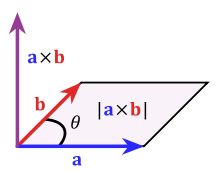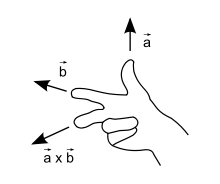Cross product
![]()
This article is about the product of two vectors in space; for other meanings, see Cross product (disambiguation).
The cross product, also known as vector product, vectorial product, or outer product, is a linkage in three-dimensional Euclidean vector space that assigns a vector to two vectors again. To distinguish it from other products, especially the scalar product, it is written in German- and English-speaking countries with a paint cross 
The cross product of the vectors 



In physics, the cross product occurs in many places, for example in electromagnetism when calculating the Lorentz force or the Poynting vector. In classical mechanics, it is used for angular quantities such as torque and angular momentum, or for apparent forces such as the Coriolis force.

Cross product
Geometric definition
The cross product 






This vector is oriented such that 









The magnitude of 




Where 





In summary
where the vector 




Right hand rule
Spellings
Depending on the country, different notations are used for the vector product. In English and German-speaking countries, the vector product of two vectors 



![{\displaystyle [{\vec {a}},{\vec {b}}]}](https://www.alegsaonline.com/image/008d8868e90625dc41200b2396382596923b8d9c.svg)
![{\displaystyle [{\vec {a}}\ {\vec {b}}]}](https://www.alegsaonline.com/image/f525d35f8edddf7a3f90c4d8666e165cc0ac5a00.svg)
The notation 
Questions and Answers
Q: What is the cross product?
A: The cross product is a mathematical operation that can be done between two three-dimensional vectors.
Q: How is the cross product often represented?
A: The cross product is often represented by the symbol × or \times.
Q: What happens after performing the cross product?
A: After performing the cross product, a new vector is formed.
Q: What is the relationship between the cross product vector and the vectors that were "crossed"?
A: The cross product of two vectors is always perpendicular (it makes a corner-shaped angle) to both of the vectors which were "crossed".
Q: In what dimension does the cross product normally work?
A: Cross product normally works only in three-dimensional space.
Q: What are the three dimensions where cross product can be performed?
A: The three dimensions where cross product can be performed are up or down, left or right, and forward or backwards.
Q: Why can cross product normally only work in three-dimensional space?
A: Cross product normally works only in three-dimensional space because those are the dimensions where you can go up or down, left or right, and forward or backwards.
Search within the encyclopedia

